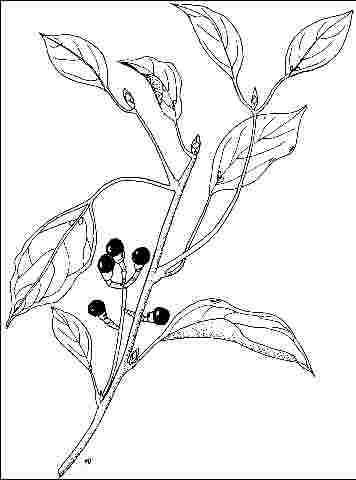Introduction
This round-canopied, evergreen tree has broad, large-diameter, unusually strong branches. The ‘Monum’ cultivar reportedly grows only to 40 feet in height with a narrower spread, contrasting with the larger size of the species. The glossy green, thin and leathery leaves give off a camphor aroma when crushed and create dense shade. Leaves of this cultivar are larger than the species. The stems and bark on young branches of camphor-tree are bright green, tinged with red when young, maturing into a dark grey-brown, rugged-looking trunk which appears almost black when wet from rain. Trunk and branch structure on older trees appear similar to mature live oaks. The inconspicuous, tiny, yellow flowers are followed by a profusion of small, black berries which can become an annoyance on walks and driveways because they are messy but are quite attractive to wildlife. Fruits will stain cars. Some occasionally germinate below the tree but not nearly as much of a problem as some other trees. Birds can also carry the seed to remote areas where it will occasionally germinate. The species is considered invasive in north and central Florida, and is therefore not recommended in those regions, but may be used with caution in south Florida. The leaves, twigs, and wood are the commercial source of camphor. The dried bark of Cinnamomum zeylanicum yields cinnamon.

General Information
Scientific name: Cinnamomum camphora
Pronunciation: sin-uh-MOE-mum kam-FOR-uh
Common name(s): 'Monum' camphor-tree
Family: Lauraceae
USDA hardiness zones: 9B through 11 (Figure 2)
Origin: not native to North America
Invasive potential: invasive and not recommended (North, Central); caution, may be recommended but manage to prevent escape (South)
Uses: urban tolerant; screen; shade

Description
Height: 35 to 40 feet
Spread: 25 to 35 feet
Crown uniformity: symmetrical
Crown shape: round
Crown density: dense
Growth rate: moderate
Texture: medium
Foliage
Leaf arrangement: alternate (Figure 3)
Leaf type: simple
Leaf margin: entire
Leaf shape: ovate, obovate
Leaf venation: pinnate
Leaf type and persistence: evergreen, broadleaf evergreen, fragrant
Leaf blade length: 2 to 4 inches
Leaf color: green
Fall color: no color change
Fall characteristic: not showy

Flower
Flower color: yellow
Flower characteristics: not showy
Fruit
Fruit shape: round
Fruit length: less than .5 inch
Fruit covering: fleshy
Fruit color: black
Fruit characteristics: attracts squirrels/mammals; not showy; fruit/leaves a litter problem
Trunk and Branches
Trunk/bark/branches: branches droop; showy; typically one trunk; thorns
Pruning requirement: needed for strong structure
Breakage: resistant
Current year twig color: green
Current year twig thickness: thin, medium
Wood specific gravity: unknown
Culture
Light requirement: full sun, partial sun or partial shade
Soil tolerances: sand; loam; clay; acidic; slightly alkaline; well-drained
Drought tolerance: high
Aerosol salt tolerance: low
Other
Roots: can form large surface roots
Winter interest: yes
Outstanding tree: no
Ozone sensitivity: unknown
Verticillium wilt susceptibility: susceptible
Pest resistance: resistant to pests/diseases
Use and Management
This cultivar of camphor-tree is ideally used as a shade tree in parks or medium or large-sized landscapes. It might be suited for street tree planting where cars do not park and sidewalk usage is low. Prune to develop major branches, space 18 to 30 inches apart along a central trunk to develop good structure. Do not allow major branches to grow from the same spot on the trunk and avoid upright, multi-trunked trees. It may be difficult to maintain a lawn beneath the dense shade of a camphor-tree and a shade-tolerant groundcover may better suit the purpose. The trunk on older specimens of the species grows to six feet or more in diameter and is quite picturesque, but the cultivar is probably much smaller. Shallow roots can be a nuisance. The species is considered invasive in north and central Florida and should be used with caution in south Florida.
It can be grown in full sun to partial shade. Camphor-tree is amenable to a variety of soils, will grow but often develops minor element deficiencies on alkaline soils. Camphor-tree is highly tolerant of urban conditions but will not tolerate water-logged soils. It is adapted to grow along the coast exposed to some sea salt.
Pests
Scales and mites are common problems on camphor-trees. Seeds of the species can germinate easily in the landscape.
Diseases
Camphor-Tree is subject to root rot, especially in poorly-drained soils.
Literature Cited
Fox, A.M., D.R. Gordon, J.A. Dusky, L. Tyson, and R.K. Stocker. 2008. UF/IFAS Assessment of Non-Native Plants in Florida's Natural Areas: Status Assessment. Cited from the Internet (November 16, 2012), https://plants.ifas.ufl.edu/assessment/pdfs/status_assessment.pdf